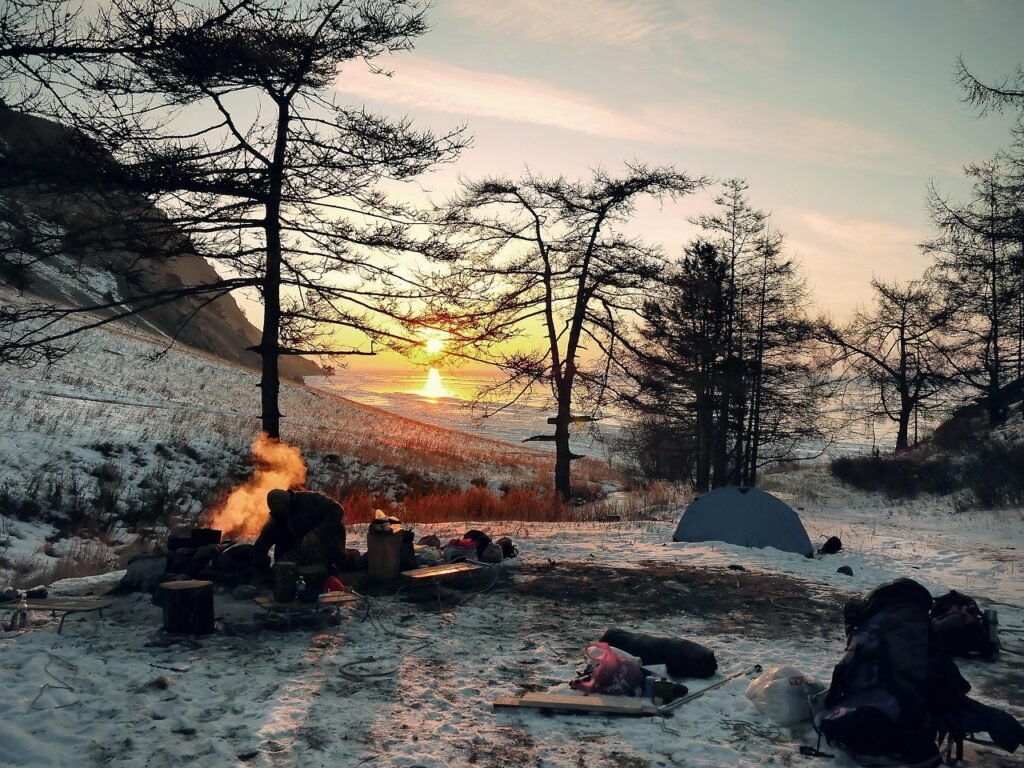How to Camp in Cold Weather: A Complete Cold Weather Camping Guide
Camping in the great outdoors doesn’t need to stop when the temperature drops. In fact, learning how to camp in cold weather can open up a world of serene, crowd-free landscapes, unique challenges, and unforgettable adventures. With the right preparation, equipment, and mindset, winter camping can be just as enjoyable—if not more so—than fair-weather trips.
In this comprehensive guide, we’ll show you how can practice cold weather camping the safe and smart way. Whether you’re a first-timer or a seasoned backpacker, these tips and strategies will help you stay warm, dry, and comfortable when the mercury dips.

Why Cold-Weather Camping is Worth It
Before we dive into techniques and gear, let’s talk about why anyone would want to brave freezing temperatures in the first place.
Benefits of Camping in the Cold
- Fewer crowds: Many popular campsites are nearly empty in winter.
- No bugs: Say goodbye to mosquitoes and ticks.
- Stunning landscapes: Snowy forests, frosted peaks, and crystal-clear air.
- A sense of solitude: The silence of winter brings a different kind of peace.
- Personal challenge: There’s something deeply rewarding about mastering the elements.
How to Camp in Cold Weather: The Essentials
Let’s explore the most critical components of a successful cold-weather camping experience.
1. Choose the Right Campsite
Location is everything—especially in the winter.
What to Look For:
- Shelter from wind: Set up camp behind natural windbreaks like trees, ridges, or boulders.
- Avoid valleys: Cold air settles in low-lying areas; aim for slightly higher ground.
- South-facing slope: These spots catch more sun during the day.
- Flat ground: Helps prevent water pooling and uncomfortable sleeping conditions.
2. Dress in Layers
Your clothing system is your first line of defense against hypothermia and frostbite.
Layering System:
- Base Layer: Moisture-wicking fabric (merino wool or synthetic).
- Mid Layer: Insulating material like fleece or down.
- Outer Layer: Waterproof and windproof shell (Gore-Tex or similar).
Add accessories:
- Warm hat (you lose up to 10% of heat through your head).
- Insulated gloves or mittens.
- Wool socks (bring extras).
- Neck gaiter or balaclava.
Pro tip: Avoid cotton—it holds moisture and will make you cold fast.
3. Invest in a Winter Sleeping System
Sleeping comfortably is essential when learning how to camp in cold weather.
Sleeping Bag:
- Choose a bag rated 10°F colder than expected nighttime temps.
- Opt for mummy-style bags for better heat retention.
- Down bags are lighter, but synthetic bags perform better in wet conditions.
Sleeping Pad:
- Use two pads: one closed-cell foam pad and one insulated inflatable pad.
- Aim for a combined R-value of 4.5 or higher.
Extra Sleep Tips:
- Put a hot water bottle in your sleeping bag.
- Wear dry clothes to bed.
- Insulate yourself from the ground—most heat loss happens there.
4. Master Cold-Weather Cooking
Keeping your calorie intake high helps fuel your body’s heat production.
Cooking Tips:
- Choose high-fat, high-carb foods: they burn slower and keep you warm.
- Use a liquid-fuel stove like white gas (better performance in cold).
- Avoid long cooking times: prep meals like instant ramen, oatmeal, or dehydrated dishes.
- Bring snacks: trail mix, jerky, chocolate, and cheese.
Always store food properly to prevent attracting wildlife.
Cold-Weather Camping Gear Checklist
Packing the right gear can make or break your winter adventure.
Shelter:
- Four-season tent or sturdy 3-season tent with strong poles and steep walls
- Tent footprint or tarp
- Snow stakes or deadman anchors
Sleep System:
- Winter-rated sleeping bag (down to at least 0°F if needed)
- Insulated sleeping pad + foam pad
- Pillow or stuff sack filled with clothes
Cooking & Water:
- Insulated stainless steel bottles (avoid freezing)
- Liquid-fuel stove + windscreen
- Fuel (more than usual—cold uses more)
- Lighter and waterproof matches
- Food stored in hard-sided container or bear bag
Clothing:
- Base, mid, and outer layers
- Insulated jacket (down or synthetic)
- Waterproof boots
- Gaiters (for snow and moisture)
- Wool or synthetic socks
- Gloves, liners, and mittens
- Hat, balaclava, or face mask
Safety & Extras:
- Headlamp + extra batteries
- First aid kit
- Hand warmers
- Multi-tool
- Map + compass or GPS
- Avalanche gear (if in snowy mountain terrain)
How to Stay Warm While Camping in Cold Weather
Even with good gear, you need techniques to stay warm.
1. Eat Before Bed
A calorie-dense meal stokes your internal furnace. Don’t skip dinner—your body needs fuel to produce heat overnight.
2. Stay Dry
Moisture is the enemy. Sweat, snow, and condensation can all sap warmth. Change into dry clothes when possible and ventilate your tent to reduce condensation.
3. Keep Moving (But Don’t Sweat)
Moderate activity keeps blood flowing. Take short walks, do light exercises—but don’t overdo it and sweat.
4. Sleep with Tomorrow’s Clothes
Stuff tomorrow’s base layers into your sleeping bag to keep them warm and dry. This saves you from the morning freeze-shock.
5. Use a Hot Water Bottle
Boil water, fill a leakproof bottle, and tuck it near your core or feet inside your sleeping bag.
Cold Weather Camping Safety Tips
Knowing how to camp in cold weather also means knowing how to recognize and respond to danger.
Recognize Hypothermia:
- Shivering
- Slurred speech
- Confusion
- Clumsiness
Frostbite Warning Signs:
- Numbness
- Pale, hard skin
- Burning or tingling
If symptoms appear:
- Get into shelter immediately
- Warm affected areas slowly—don’t rub frozen skin
- Seek emergency help if severe
How to Camp in the Snow
If you’re venturing into deep snow, follow these additional strategies:
1. Pack Down Your Tent Area
Use snowshoes or your feet to tamp down the snow where you’ll pitch your tent. Let it set for 30 minutes to create a solid platform.
2. Dig Cold-Air Trenches
Dig a trench under your tent’s vestibule area. Cold air sinks into it, creating a thermal barrier near your sleeping area.
3. Use Snow Anchors
Standard tent stakes won’t work. Use snow stakes or bury your anchors horizontally in packed snow.
4. Bring Snow-Specific Gear
Snow shovel, avalanche beacon, probe, and snowshoes may be necessary depending on terrain.
Cold-Weather Camping for Beginners
If you’re just learning how to camp in cold weather, start simple.
Try These Beginner Tips:
- Camp close to home or your vehicle
- Pick a mild forecast (above 20°F)
- Go with an experienced buddy
- Test your gear beforehand in your backyard
Start small and build confidence before attempting backcountry winter trips.
FAQs About Camping in Cold Weather
What temperature is too cold to camp in?
It depends on your gear and experience, but many avoid camping below 0°F without specialized equipment.
Can you use a regular tent in cold weather?
Three-season tents can work in light snow and mild cold, but four-season tents are better for wind and heavy snow.
How do you keep your water from freezing?
Use insulated bottles, store them upside down, and bury them in snow or wrap them in clothing inside your pack.
What foods are best for cold-weather camping?
High-fat, high-calorie foods like peanut butter, cheese, trail mix, and pasta provide long-lasting energy.
Final Thoughts: Embrace the Chill
Cold-weather camping doesn’t need to be intimidating. With the right knowledge and a little preparation, you’ll not only learn how to camp in cold weather, but you’ll come to love the crisp air, quiet trails, and pristine beauty that only winter provides.
So pack your thermals, grab your sleeping bag, and hit the snowy trail. The cold might bite, but the memories you’ll make will warm your soul for years to come.
